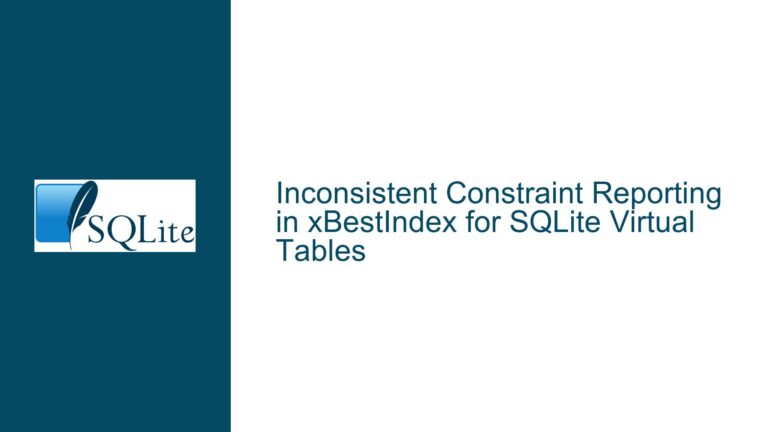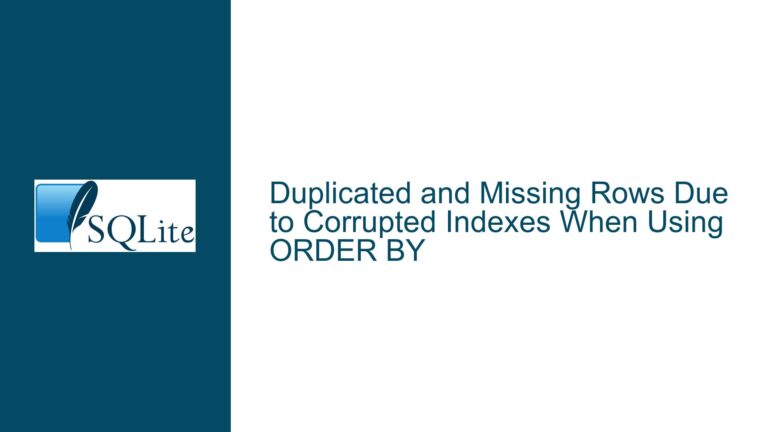Parallel Index Creation in SQLite Using Begin Concurrent and Schema Manipulation
Parallel Index Creation Challenges with Schema Modifications and Begin Concurrent
Creating multiple indexes on a large table in SQLite can be a time-consuming process, especially when dealing with millions of rows. The need for parallel index creation arises to optimize this process, but SQLite’s default behavior of locking the entire database during write operations poses significant challenges. This post delves into the intricacies of parallel index creation using the begin concurrent feature, schema manipulation, and the potential pitfalls and solutions associated with these techniques.
Understanding the Core Issue: Parallel Index Creation and Schema Conflicts
The primary issue revolves around the need to create multiple indexes on a large table with over 10 million rows. The table contains a JSON column, and most of the indexes are on the values extracted from this JSON object. Creating these indexes sequentially is time-consuming, and the goal is to parallelize this process to save time.
The begin concurrent feature in SQLite allows for concurrent write operations by applying locks at the page level rather than the entire database. However, creating indexes involves modifying the schema table (sqlite_schema), which leads to page conflicts when multiple connections attempt to create indexes simultaneously. This is because the schema table is shared across all connections, and any modification to it requires exclusive access.
To circumvent this, the idea of creating empty indexes on a dummy table and then transferring these indexes to the main table by manipulating the sqlite_schema table was proposed. This approach aims to avoid schema conflicts by ensuring that the actual index creation (recalculation) happens in parallel without modifying the schema table simultaneously.
Potential Causes of Issues in Parallel Index Creation
Several factors contribute to the challenges faced in parallel index creation:
Schema Table Modifications: The
sqlite_schematable is a critical component of SQLite’s database schema. Any modification to this table, such as creating or dropping indexes, requires exclusive access. When multiple connections attempt to modify the schema simultaneously, it leads to page conflicts, causing the operations to fail or resulting in a "database is locked" error.WAL Mode Limitations: While Write-Ahead Logging (WAL) mode allows for concurrent reads and writes, it does not entirely eliminate conflicts when multiple connections attempt to modify the schema. The
begin concurrentbranch aims to address this by allowing page-level locking, but it is still under development and not yet merged into the main SQLite trunk.Index Creation Overhead: Creating an index involves scanning the entire table, sorting the data, and writing the index pages to disk. This process is resource-intensive and time-consuming, especially for large tables. Even with parallel execution, the overhead of creating multiple indexes can lead to performance bottlenecks.
Schema Manipulation Risks: Manipulating the
sqlite_schematable directly usingPRAGMA writable_schema=ONis risky and can lead to database corruption if not done correctly. This approach requires precise execution and a deep understanding of SQLite’s internal workings.Connection Cache and Busy Timeout Settings: The performance of parallel index creation can be influenced by the connection cache size and busy timeout settings. Inadequate cache size or insufficient busy timeout can lead to frequent retries and increased contention, further slowing down the process.
Detailed Troubleshooting Steps, Solutions, and Fixes
Step 1: Preparing the Environment for Parallel Index Creation
Before attempting parallel index creation, ensure that the database is in WAL mode. This mode allows for better concurrency by enabling multiple readers and a single writer to operate simultaneously without blocking each other.
PRAGMA journal_mode=WAL;
Additionally, set an appropriate cache size and busy timeout for each connection to minimize contention and retries:
PRAGMA cache_size=-20000; -- Set cache size to 20,000 pages
PRAGMA busy_timeout=30000; -- Set busy timeout to 30,000 milliseconds
Step 2: Creating Empty Indexes on a Dummy Table
To avoid schema conflicts, create empty indexes on a dummy table. This step involves creating a dummy table with the same structure as the main table and then creating the desired indexes on this dummy table.
CREATE TABLE dummy(json);
CREATE INDEX dummy_a_idx ON dummy(json ->> 'a' ASC);
CREATE INDEX dummy_b_idx ON dummy(json ->> 'b' ASC);
Step 3: Transferring Indexes to the Main Table Using Schema Manipulation
Once the empty indexes are created on the dummy table, transfer them to the main table by manipulating the sqlite_schema table. This step requires enabling the writable_schema pragma and updating the sqlite_schema entries to point to the main table.
PRAGMA writable_schema=ON;
UPDATE sqlite_schema
SET sql = REPLACE(sql, 'ON dummy(', 'ON proper('),
tbl_name = 'proper'
WHERE type = 'index' AND name LIKE 'dummy_%';
PRAGMA writable_schema=RESET;
This update changes the table name in the index definitions from dummy to proper, effectively transferring the indexes to the main table.
Step 4: Reindexing in Parallel Using Begin Concurrent
With the indexes now pointing to the main table, you can proceed to reindex them in parallel using separate connections. Each connection should start with begin concurrent to enable page-level locking and avoid database-level locks.
BEGIN CONCURRENT;
REINDEX a_idx;
COMMIT;
Repeat this process for each index in separate connections. The begin concurrent feature ensures that each reindex operation locks only the pages it needs, allowing multiple reindex operations to proceed in parallel without conflicts.
Step 5: Monitoring and Optimizing Performance
Monitor the performance of the parallel reindex operations to ensure that they are proceeding as expected. Use SQLite’s built-in timing and statistics features to track the execution time and resource usage.
.timer on
.stats on
If performance issues arise, consider adjusting the cache size and busy timeout settings further. Additionally, ensure that the database file is stored on a fast storage medium to minimize I/O bottlenecks.
Step 6: Handling Edge Cases and Potential Issues
While the above steps provide a robust framework for parallel index creation, several edge cases and potential issues may arise:
Database Corruption: Direct manipulation of the
sqlite_schematable carries the risk of database corruption. Always back up the database before attempting schema modifications.Index Consistency: Ensure that the indexes are consistent after the reindex operation. Use the
PRAGMA integrity_checkcommand to verify the database’s integrity.Concurrency Limits: The
begin concurrentfeature is still under development and may have limitations. Test the process thoroughly in a staging environment before applying it to production.Resource Contention: High levels of concurrency can lead to resource contention, especially on systems with limited CPU or I/O bandwidth. Monitor system resources and adjust the number of parallel connections accordingly.
Schema Changes: Any changes to the table schema after the indexes have been transferred may require re-evaluating the index definitions. Ensure that the schema remains stable during the parallel index creation process.
Conclusion
Parallel index creation in SQLite is a complex but achievable task that requires careful planning and execution. By leveraging the begin concurrent feature, manipulating the sqlite_schema table, and optimizing connection settings, you can significantly reduce the time required to create multiple indexes on large tables. However, this approach comes with risks, particularly when directly modifying the schema table. Always back up your database, monitor performance, and test thoroughly in a controlled environment before applying these techniques to production systems. With the right precautions, parallel index creation can be a powerful tool for optimizing SQLite database performance.






